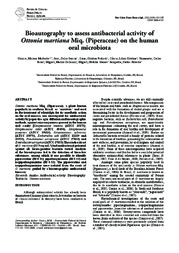Bioautography to assess antibacterial activity of Ottonia martiana Miq. (Piperaceae) on the human oral microbiota.
Bioautography to assess antibacterial activity of Ottonia martiana Miq. (Piperaceae) on the human oral microbiota.
Author(s): CUNICO, M. M.; AUER, C. G.; LIMA, C. P. de; CÔCCO, L. C.; YAMAMOTO, C. I.; MIGUEL, M. D.; MIGUEL, O. G.; SANQUETTA, C. R.
Summary: Ottonia martiana Miq. (Piperaceae), a plant known popularly in southern Brazil as “anestésia” and used in the treatment of odontalgia for its anesthetic action on the oral mucosa, was investigated for antibacterial activity by paper disc agar diffusion and bioautographic methods, against microorganisms present in the human oral cavity [Streptococcus mutans (ATCC 25175), Streptococcus mitis (ATCC 49456), Streptococcus pyogenes (ATCC 19615), Streptococcus salivarius (ATCC 25975), Escherichia coli (ATCC 11229 and 25922), Pseudomonas aeruginosa (ATCC 27853) and Enterobacter aerogenes (ATCC 27853).The crude extract of O. martiana (32.9 mg mL-1) had antibacterial potential against all Gram-positive bacteria tested. Analysis of the bioautograms led to the detection of bioactive substances, among which it was possible to identify piperovatine (Rf 0.35), piperlonguminine (Rf 0.52) and isopiperlonguminine (Rf 0.52). The piperovatine and isopiperlonguminine were isolated from the roots of O. martiana, guided by a bioautographic antibacterial bioassay.
Publication year: 2012
Types of publication: Journal article
Unit: Embrapa Forestry
Keywords: Amido, Atividade antibacteriana, Dor de dente, Ottonia martiana
Observation
Some of Embrapa's publications are published as ePub files. To read them, use or download one of the following free software options to your computer or mobile device. Android: Google Play Books; IOS: iBooks; Windows and Linux: Calibre.
Access other publications
Access the Agricultural Research Database (BDPA) to consult Embrapa's full library collection and records.
Visit Embrapa Bookstore to purchase books and other publications sold by Embrapa.

